|
|
|
Panzerkampfwagen II (Sd.Kfz. 121)

In
General
The
PzKpfw II was the second German tank introduced before the war
began. The main reason was the fact that the production of the
larger tanks like the PzKpfw III and the PzKpfw IV were going to
be delayed. The German factories had some problems in making
these heavy tanks and it became clear that the production would
last until 1938.
The specifications for this tank were released in
1935 to Krupp, MAN, Henschel and Daimler – Benz. Krupp only
changed the dimension and the armament of the Panzerkampfwagen I.
The other three manufacturers came up with a totally new design
in both chassis and hull. The Wehrmacht tested the vehicle and
gave their permission to MAN and Daimler – Benz. The first
one would provide the chassis, while the second manufacturer
would provide the hull…
PzKpfw
II, Ausf. a1, a2, a3, b
The
first types of the PzKpfw II were actually prototypes. They were
designated as Ausf. a1, Ausf. a2, Ausf. a3 and Ausf. b. The
delivery for these tanks were slow for the next 18 months as
changes were made in the design. Between late 1935 and the
beginning of 1937, only 110 tanks were made by MAN and Daimler
– Benz. Compared to the PzKpfw I, the armour was increased
in thickness and some changes were made in the suspension. All
these vehicle were powered by a Maybach-engine. The Ausf. b had
an improved cooling system and driving sprockets.
Also the armament was an improvement of the
Panzerkampfwagen I, but still not very effective. These tanks had
one 2cm KwK 30 L/55 automatic cannon and one 7.92mm MG34 machine
gun in the turret. The penetration of the 2cm rounds was not very
impressive in a tank-battle. Most of the PzKpfw II, Ausf.
b’s were used in the Spanish Civil War and when the
opposition wasn’t too strong, they were able to compete in
an armoured role. However they were no match for a 45mm anti-tank
gun or a 45mm gun mounted in a Russian T26…
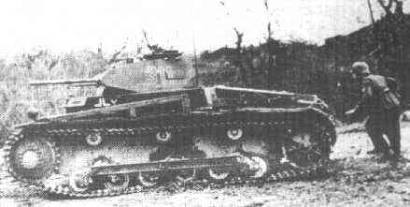
Side view from a PzKpfw II, Ausf a in action (note the hull
front).
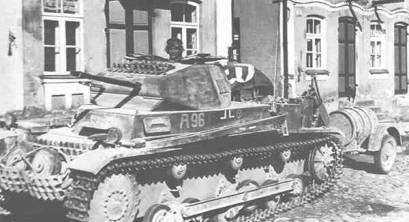
The suspension of the PzKpfw II, Ausf. b consists of three pairs
of small road wheels and three return rollers.
Crew: 3 (driver , commander/gunner,
radio-operator)
Weight
(PzKpfw II, Ausf. a1, a2, a3) : 7.6 ton
Weight
(PzKpfw II, Ausf. b) : 7.9 ton
Length:
4.76m
Width:
2.14m
Height:
1.99m
Range
(max): 200 km
Engine
(PzKpfw II, Ausf. a1, a2, a3) : Maybach HL 57 TR
Engine
(PzKpfw II, Ausf. b) : Maybach HL 62 TR
Speed
(max): 40 km/hr
Armament:
1 x KwK 30 L/55 (20mm) and 1 x MG 34 (7.92mm)
No.
Produced: 110
PzKpfw
II, Ausf. c
After
March 1937, a new variant arrived on the scene. It was the PzKpfw
II, Ausf. c. This tank had lots of improvements. First of all the
suspension was changed from six small road wheels into five
medium sized road wheels and four return rollers. This was to
become standard on the following PzKpfw II models. The tracks
showed a new design, which meant that the drive sprockets had to
be modified. Finally the ventilation and the cooling of the
engine compartment was improved. As originally intended, the
PzKpfw II, Ausf. c had a split hatch on the roof for the
commander, and a rounded hull front…
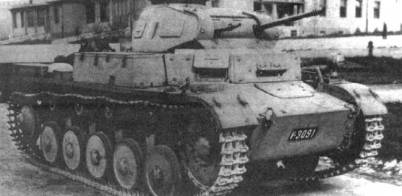
This tank belonged to the Slovak Army. Note the small Slovak
shield on the turret in white, blue and red.
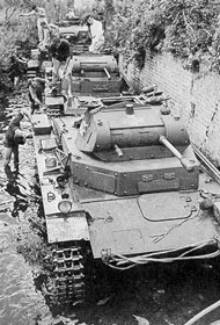
This view shows the entrance for the commander (split hatch on
top) and the entrance for the driver.
Crew: 3 (driver , commander/gunner,
radio-operator)
Weight:
8.9 ton
Length:
4.81m
Width:
2.22m
Height:
1.99m
Range
(max): 200 km
Engine:
Maybach NL 38 TR
Speed
(max): 40 km/hr
Armament:
1 x KwK 30 L/55 (20mm) and 1 x MG 34 (7.92mm)
No.
Produced: 1900
PzKpfw
II, Ausf. A
This
was going to be the first real production model of the PzKpfw II.
It was almost identical to the earlier Ausf. c model, with the
main difference being the flattened hull front. As mentioned
above, the crew consisted out of three men. Once inside the tank,
the driver sat on the left of the hull, and he had three vision
slits. The radio-operator also sat in the hull, but at the rear
of the fighting compartment. He had one vision slit which faced
to the rear of the tank. The commander/gunner sat in the turret.
There was no floor, so his seat was attached to the side of the
turret. There were 2 vision slits on the left of the turret, one
on the right and one to the rear.
There was no power traverse available to the
commander; instead he had a traverse hand wheel to his right,
which also contained the fire button for the machine gun. And on
his left, there was an elevation hand wheel with the fire button
for the 2 cm cannon. For aiming the weapons, there was a TFZ4
telescope on board. Sometimes there were five smoke canisters
attached on the rear of the hull. These were used by pulling a
wire in the fighting compartment, and providing the vehicle with
it’s own smoke screen…
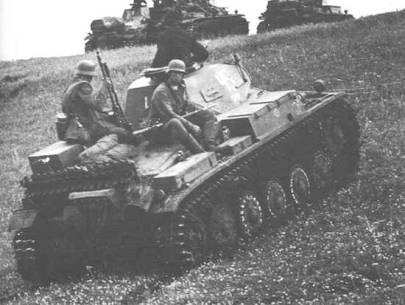
PzKpfw II, Ausf. A in France, 1940.
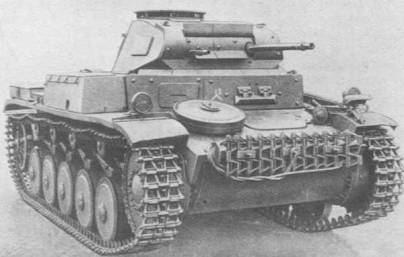
Static display from a PzKpfw II, Ausf. A.
Crew:
3 (driver , commander/gunner, radio-operator)
Weight:
9.5 ton
Length:
4.81m
Width:
2.28m
Height:
2.02m
Range
(max): 200 km
Engine:
Maybach HL 62 TRM
Speed
(max): 40 km/hr
Armament:
1 x KwK 30 L/55 (20mm) and 1 x MG 34 (7.92mm)
No. Produced:
1000
PzKpfw
II, Ausf. B, C
These
two tanks are pretty much the same as their predecessor. All
these tanks (Ausf. c, A, B and C) were made by either MAN,
Daimler – Benz, Henschel, Wegmann, Alkett, MIAG or Famo, or
a mix from these. One big advantage of these tanks compared to
the PzKpfw II, Ausf. b was the fact that the crew could
communicate perfectly. This Panzerkampfwagen had three radios,
two receivers and one transmitter. All crewmen had speech- and
listening devices, with the driver and commander able to
communicate through a voice tube. This could be a fact to explain
the early successes of the German armour. Not only were the tanks
able to communicate with each other mutual, it also allowed the
crew to keep in contact. And that was a very important feature in
the heat of battle. This was something the tanks of many other
nations did not have in the early days of the war. The Ausf. A
was also fitted with noise suppressors around the engine to allow
the crew to hear the radio more easily…
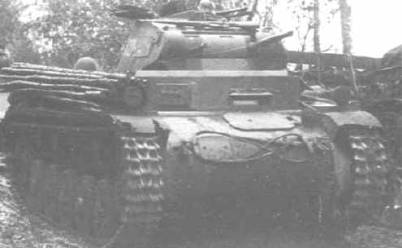
PzKpfw II, Ausf. B.
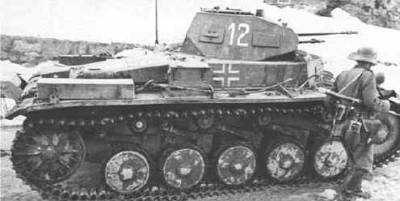
PzKpfw II, Ausf. C in Norway, 1940.
Crew:
3 (driver , commander/gunner, radio-operator)
Weight:
9.5 ton
Length:
4.81m
Width:
2.28m
Height:
2.02m
Range
(max): 200 km
Engine:
Maybach HL 62 TRM
Speed
(max): 40 km/hr
Armament:
1 x KwK 38 L/55 (20mm) and 1 x MG 34 (7.92mm)
No. Produced:
3000
PzKpfw
II, Ausf. D/E
In
May of 1938, MAN produced a light tank which was intended for
mechanised cavalry units or light divisions. Its official name
was PzKpfw II, Ausf. D/E, but it was better know as the Schnellkampfwagen
or fast fighting vehicle. The turret remained the same as its
predecessor, all the rest was changed or modified. The biggest
modifications were the torsion bars with four large road wheels
and no return rollers.
But only less than 50 tanks were made and these saw
action during the Polish campaign. After the bad experience with
the rather unsuccessful suspension, all PzKpfw II, Ausf. D/E were
taken out of service and converted to flamethrower tanks or
Marders…
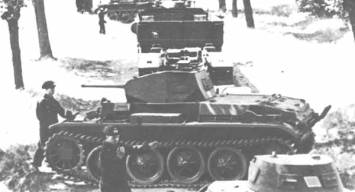
The large road wheels of this PzKpfw II, Ausf. D/E are clearly
visible. Up front there’s a turret from a PzKpfw I, Ausf. A.
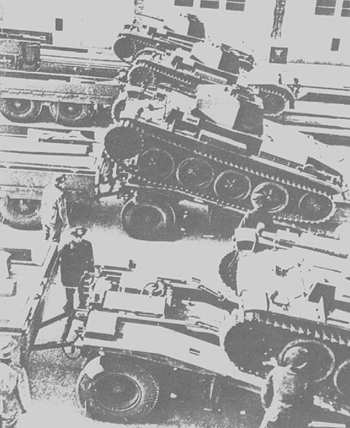
Some PzKpfw II, Ausf. D/E’s are leaving the factory in
Germany.
Crew:
3 (driver , commander/gunner, radio-operator)
Weight:
10.0 ton
Length:
4.64m
Width:
2.30m
Height:
2.02m
Range
(max): 200 km
Engine:
Maybach HL 62 TRM
Speed
(max): 55 km/hr
Armament:
1 x KwK 38 L/55 (20mm) and 1 x MG 34 (7.92mm)
No. Produced:
43
PzKpfw
II, Ausf. F
The
production of the PzKpfw II, Ausf. F began in 1941 by the Famo
factory and ended in late 1942. It was the last Panzerkampfwagen
II to enter the battlefields with a tank-role. This tank was only
built to maintain tank production, while the production of the
new tanks was getting into full swing. The F-variant had few
changes from earlier models, and in fact it was an up armoured
Ausf. C. The front armour was thicker than its predecessor, which
meant a slight loss of speed. Another remarkable thing was the
fact that there was a dummy visor to the right of the drivers
slit. This may have been to draw fire away from the driver’s
position...
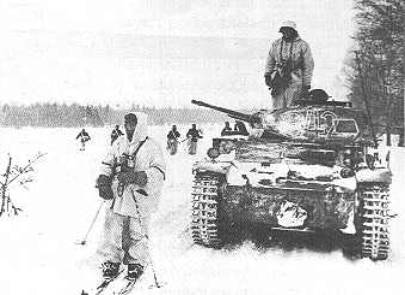
PzKpfw II, Ausf. F from the 5th Panzer Division on his
way to Moscow.
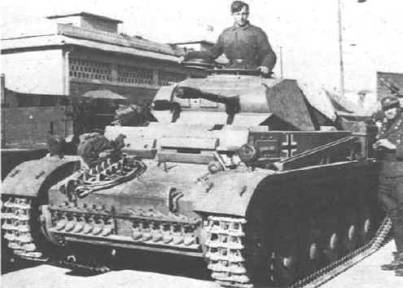
On this picture the dummy vision slit for the driver is visible
on the right.
Crew:
3 (driver , commander/gunner, radio-operator)
Weight:
9.5 ton
Length:
4.81m
Width:
2.28m
Height:
2.15m
Range
(max): 200 km
Engine:
Maybach HL 62 TR
Speed
(max): 40 km/hr
Armament:
1 x KwK 38 L/55 (20mm) and 1 x MG 34 (7.92mm)
No. Produced:
524
PzKpfw
II, Ausf. G
A
new model of the PzKpfw II was seen on the drawing tables in
Germany. It was the Ausf. G, designed as a light recon vehicle
who introduced a 4th type of running gear. This tank
had five interleaved road wheels with a torsion bar suspension
and no return rollers. Originally based on the Ausf. D, it was
supposed to replace the Ausf. F. In the end, only 12 tanks were
made and they never saw any active service…
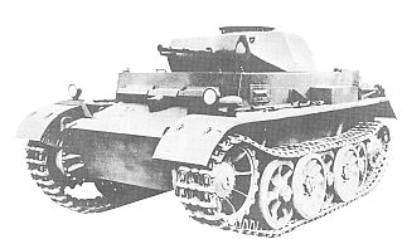
Static display of a PzKpfw II, Ausf. G.
PzKpfw
II, Ausf. J
With
an appearance similar to the Ausf. G, the Ausf. J was an attempt
to load as much armour as possible on the PzKpfw II. The weight
increased to 18 tonnes by increasing the frontal, side and rear
armour. The vehicle had a top speed of 30km/h, produced by a
Maybach HL 45 P. Twenty-two tanks were made, and only seven of
these saw action on the Eastern Front…
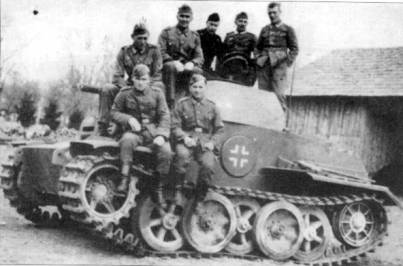
One of the seven PzKpfw II, Ausf. H’s which operated
on the Eastern Front.
Variants
PzKpfw
II, Ausf. L ‘Luchs’
This
vehicle which was also known as the Lynx (Luchs), was
intended to equip recon units of the Panzer Divisions. Of the 800
intended, just over 100 were built. The first 104 had a 2 cm KwK
38L/55 cannon. The cannon was fixed for the first time in middle
of the turret. There was also a coax mounted MG 34 to the left of
the main armament. A fourth crewmember was added. Due to thicker
armour, the weight went up to 13 tonnes. However, with the
Maybach HL 66 engine, the Luchs could reach 60km/h.
After the first 100 were built, the remaining 700
were intended to mount the 5 cm KwK 39 L/60. However, only a few
were built (35) before the production ended in mid 1943. Some of
these were fitted with radio equipment and antennas. They served
as reconnaissance communication vehicles. This tank was also
designated as Sd.Kfz 123…
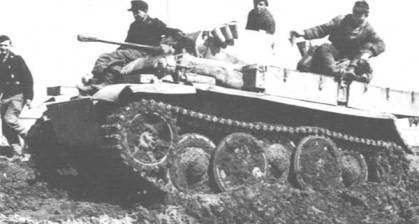
On this picture a PzKpfw II, Ausf. L ‘Luchs’ is
advancing through a muddy terrain.
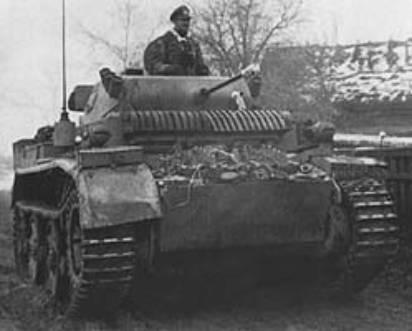
Front view of a PzKpfw II, Ausf. L ‘Luchs’. Note the
position of the 20mm cannon and the smoke canisters on the
turret.
Beobachtungswagen
II, Ausf. C
Just
like the PzKpfw I, also this tank had a command vehicle. It was a
PzKpfw II, Ausf. C with some minor changes. The turret was fixed
and a small table was installed internally with Fu2 and
Fu6-radios. When the Polish invasion began in September 1939, 96
vehicles were operational.
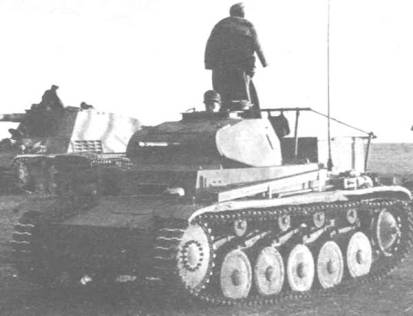
Beobachtungswagen II, Ausf. C with fixed turret and extra
antennas.
PzKpfw
II (F) ‘Flamingo’
This
variant made by MAN and Daimler – Benz was based on the
chassis of the Ausf. D/E. Some were converted while others were
built from scratch. It was armed with a single MG 34 machine gun
in the small turret. However, it’s main weapons were the two
flamethrowers, one on each front mudguard (Spitzkopfe)
that allowed them to operate at 180 degrees radius (elevation
ranged from 10 to 20 degrees). Behind each turret was a fuel tank
holding 150l, which allowed 80 shots lasting 2-3 seconds each.
The fuel tank had a shield to provide some protection, but they
were still vulnerable to enemy fire. The fuel was fired using
compressed nitrogen, and could reach some 30 m. An acetylene
flame ignited the fuel. The commander used a panel in the turret
to fire them both.
Overall 90 Flamingo’s were made between May and
December 1940. All PzKpfw II (F)’s were issued to Panzerabteilung
100 from the 18th Panzer Division and Panzerabteilung
101 from the 7th Panzer Division until 1941 to serve
in Russia. After that, both units withdrew to Germany and
reorganized there. The surviving Flamingo’s were converted
into Marder II’s. PzKpfw II (F) was used primary as a close
combat weapon working with the support of infantry…
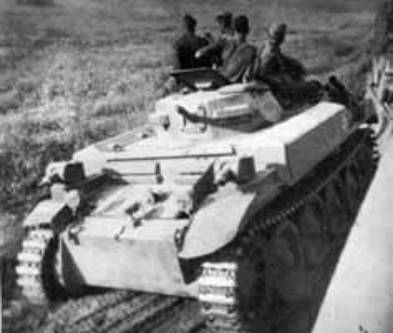
This great front view of the Flamingo shows the ‘Spitzkopfe’,
mounted on the mudguards, and the MG placed in the small turret.
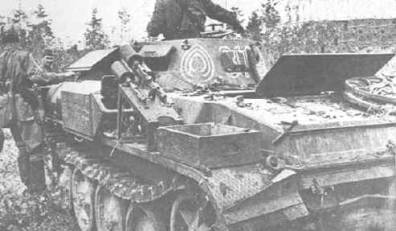
This rear view from a Flamingo shows the smoke charges under an
angle of 45 degrees. They are placed behind the fuel tanks for
the flamethrowers.
Marder
II (Sd.Kfz 132)
This
was one of the first tanks in the Marder II series. It combined
the chassis of the Ausf. D/E with a Russian 7.62cm Pak 36(r) L/51
gun. The production began in April 1942, with 200 being built by
Alkett and Wegmann until June 1943. The gun was mounted in place
of the turret, with the normal shields being the main protection
for the four-men-crew. Some vertical armour plating was placed on
the sides and front, just behind the driver’s position, but
ended just below the gun barrel.
All of the Marder series were intended to fill in
the role of Panzerjagers, basically self-propelled anti-tank
guns. But many vehicles could still be seen at the end of the
war. It was also a good way of preserving the life of obsolete
vehicles.
This Marder weighed 11.5 tonnes, and was powered by
a Maybach HL 62 TRM engine producing 140 bhp. This gave a top
speed of 40 km/h and a max range of 150 km. The maximum armour
thickness was 30mm and a 7.92mm MG 34 machine gun was
carried…
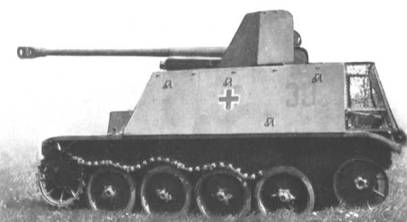
Side view from a Marder II with the Ausf. D/E chassis (with a
broken track !)
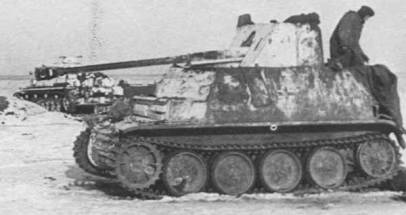
A Marder II is being prepared for combat action in Russia.
Marder
II (Sd.Kfz 131)
This
Marder II mounted a German 7.5cm Pak 40 anti-tank gun, possibly
the best German AT-gun to see large scale use, onto the chassis
of the early PzKpfw II Ausf. c, A, B, C and F. Unlike the other
Marder II, there were three crewmembers on board and they had
more protection as the armour was slightly higher on the sides
and front. However, like all Marders, this only provided
protection against small fire arms. The engine was the same as
the first Marder II, but the vehicle weighed less, 10.8 tonnes.
This meant an increased top speed up to 55km/h. Because of the
reduced weight, the maximum range was the same. A bit less than
600 were produced between June 1942 and March 1944 by FAMO, MAN
and Daimler – Benz.
Small note; Marder in English means marten,
and refers to the small creature of the weasel family…
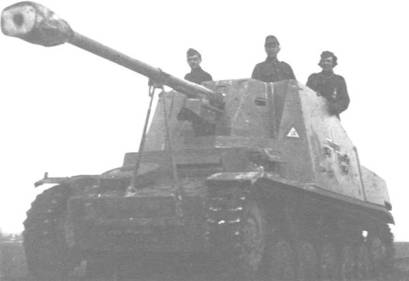
Impressive front view of a Marder II with the German anti tank
gun.
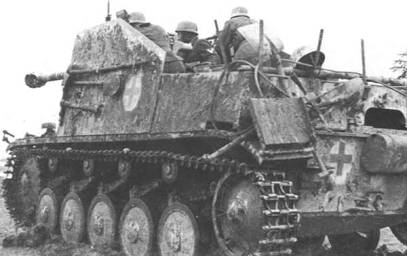
This Marder II probably belonged to a first-aid unit of the
Luftwaffe (Note the Red-cross markings and the Fallschirmjäger
helmets.)
Sturmpanzer
II ‘Bison’
Also
known as the 15cm sIG 33, this artillery piece mounted the same
gun as the PzKpfw I did, but on a larger PzKpfw II chassis. The
first prototypes made by Alkett with the normal chassis proved
inefficient though. The Alkett factory redesigned the Bison
and made twelve exemplars in 1941 and 1942. The main difference
was the change in length and width to mount the large gun. The
chassis also had an extra sixth road wheel. There was a low
shield across the front and along each side. And although the
protection for the four-men-crew was limited, the silhouette was
low. All 12 vehicles ever made were assigned to the DAK, but they
were lost by the Germans when they surrendered in North Africa
(some were lost, others abandoned and captured by the British).
The vehicle weighed approximately 13 tonnes. It had
a top speed of 45km/h produced by the Maybach HL 62 TRM petrol
engine. Based on experiences with Sturmpanzer II, the more
practical and successful Wespe was going to be developed
and produced…
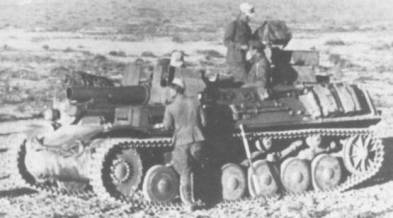
The Sturmpanzer II in North-Africa.
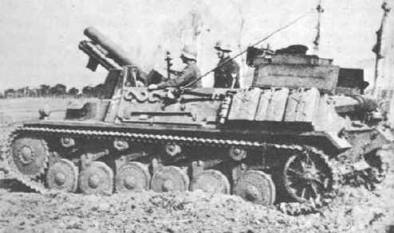
A Sturmpanzer II is waiting and/or firing somewhere in
North-Africa.
Wespe
Along
with the Marder II, this is the most well known variant of the
PzKpfw II. It mounted the 10.5 cm le FH 18/22 L/28 howitzer on
the Ausf. F chassis. Once again it was slightly lengthened to
accommodate the gun and five-men-crew. The engine was moved to
the middle of the vehicle, and the driver’s position was
moved forward, with a hatch above him.
Production began in February 1943 and ended in
September 1944, with 676 being built. The main idea behind the
design was to provide the mobile formations with indirect
artillery support. They were intended to operate behind the
frontlines. Just like the artillery, the Wespe operated in
batteries and received orders and directions from forward
observers by radio or field telephone. The vehicle was powered by
a Maybach HL 62 TRM. This gave the 11.5 tonne vehicle a top speed
of 40km/h, and a maximum range of 140km. Along with the Hummel,
the Wespe formed the backbone of the Panzer Divisions in
the later half of the war.
The vehicle first saw action during the Kursk
offensive in July 1943, and remained in use until the end of the
war. There were still some 307 in service as of March 1945…
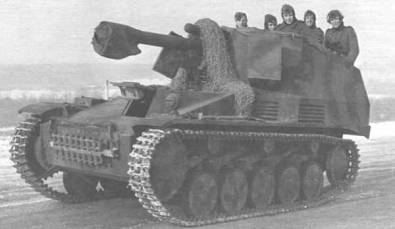
The five-men-crew is clearly visible in this Wespe.
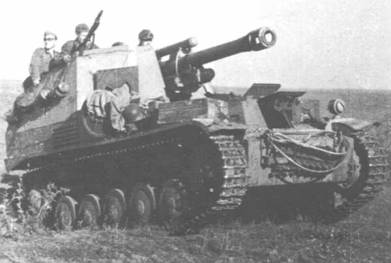
A Wespe is advancing on the Eastern Front.
By
Pz_Schrijnen